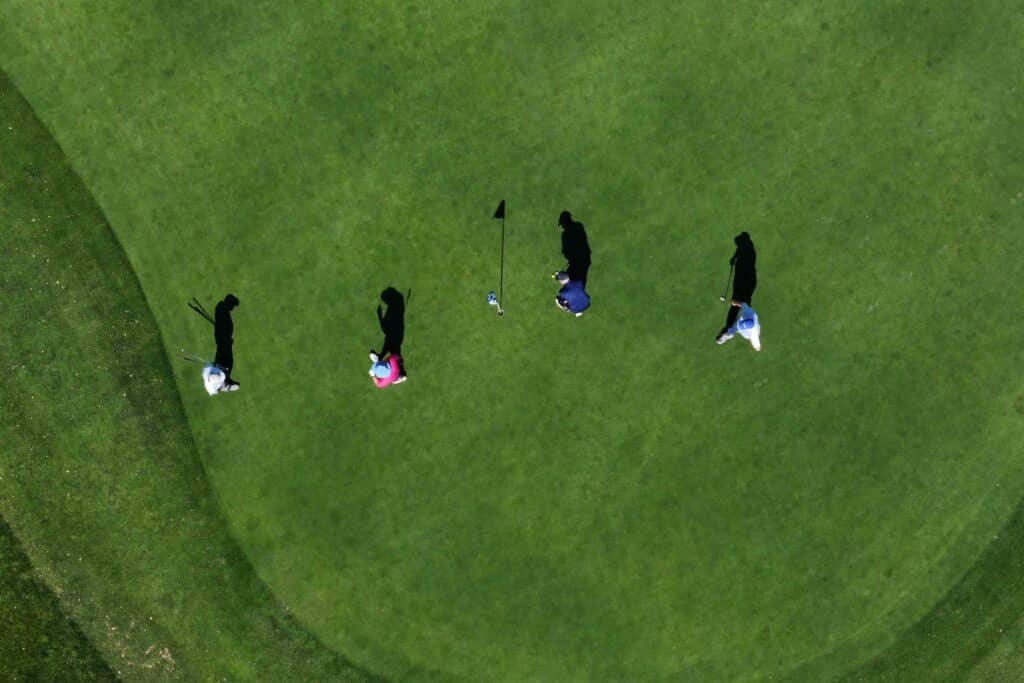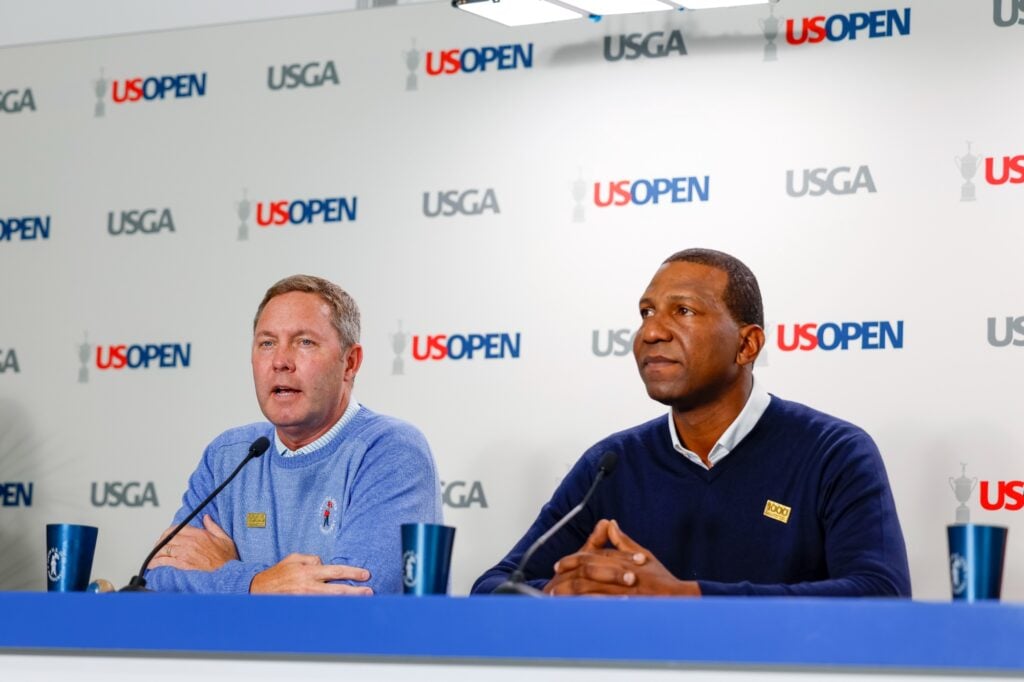It doesn’t come into force in the professional game until 2028 and it will be another two years before any of the measures apply to the rest of us at our clubs. But a golf ball roll back is coming. Its announcement by the R&A and USGA at the end of 2023 is heralding seismic changes in the game. The rumblings over its arrival continue to send the odd earthquake through our sport.
What is on the horizon? What has the reaction been to date? And what is it likely to mean for you when you’re teeing it up in the next decade?
There’s been so much written about the golf ball roll back but look no further. We’ve got everything you need right here to understand the topic, think about the consequences, and get ready for the changes…
Everything you need to know about the golf ball roll back

What is the golf ball roll back?
In December 2023, the R&A and USGA announced a universal golf ball roll back that would force everyone who plays the game – professional or amateur – to play a ball that travels a shorter distance.
The roll back comes into effect in the professional game from January 2028 and will apply to all players from January 2030.
What’s the background?
The R&A and USGA said their decision was designed to “reduce the impact increased hitting distances have on golf’s long-term sustainability while minimising the impact on the recreation game”.
A Distance Insights Project, the results of which were published in 2020, said there had been a century-long trend of increased hitting distances in golf, a cycle that was “detrimental to the game’s long-term future”.
The project also found that the strategic challenge presented by many golf courses could be compromised, “especially when those courses have not or cannot become long enough to keep up with increases in the hitting distances of the golfers who play from their longest tees”.
Advertisement
This risked, it believed, many courses “becoming less challenging, or obsolete”.
The project also raised concerns that ever increasing distance would undermine the range of skills needed to play the game successfully, would worsen pace of play, and that the game was getting too long – even off the forward tees – for many recreational golfers.

What’s going to happen?
The governing bodies will update the testing conditions that are used for golf ball conformance under the Overall Distance Standard. This is the maximum distance a ball is allowed to travel when struck. It’s currently 317 yards with a three-yard tolerance.
While that standard will remain the same, the clubhead speed used in testing will be increased from 120 to 125mph (176 to 183mph ball speed). There will be a spin rate of 2,220rpm and a launch angle of 11 degrees.
It’s the first update to those conditions since 2004, which were 120mph, 2,520rpm and 10-degree launch angle.
“An analysis of ball speeds among golf’s longest hitters in 2023 shows that the fastest ten players had an average ball speed of 186mph, while the average ball speed of the fastest 25 was 183.4mph (the very fastest averaged 190mph),” the R&A and USGA said.
It’s estimated tee shots for the average professional tour player will be reduced by 11 yards, with the very biggest hitters losing up to 15. An LET or LPGA player will see up to seven yards shaved off their drives.
Wait, didn’t I hear something about a Local Rule?
Well spotted. In March 2023, the R&A and USGA proposed a local rule that would give tournament organisers the option to require the use of a ball that didn’t travel as far.
It was designed only for use in elite competitions and was meant to have “no impact on recreational golf”. The issue was it would have basically bifurcated the sport.
Advertisement
With the R&A and USGA committed to using it in their championships – including The Open and the US Open, and the Masters likely to follow suit – it would have meant professionals club players using different equipment.
What constituted elite? The line was blurred at the top-level amateur competitions and there was a fear the leading men’s and boys would be chopping and changing between conforming balls depending on what event they were attending. Someone was bound to get disqualified.
So when the two governing bodies considered this, following a consultation period, they concluded that a Local Rule wasn’t the answer. The golf ball roll back would be universal.

What is the golf ball roll back going to mean for me?
We will be able to use our existing balls until January 2030 to “give golfers, manufacturers and retailers additional time to adjust”.
The R&A and USGA estimate the impact of a reduced distance golf ball for club players will be “five yards or less” for most.
But its real impact is likely to depend on how fast a player swings the club. The research centred on an average swing speed of 93mph for male golfers and 72mph for female players.
While it’s not a definite science, the faster you swing more likely it is you’re going to lose more distance compared with the governing body estimates.
Don’t get too concerned, though. The very biggest hitters in the game – that’s the likes of Rory McIlroy and Bryson DeChambeau – are estimated to lose no more than 15 yards.
Am I going to have to use brand new balls?
New balls please! Yes, you probably will and that’s mainly because when you buy new balls after 2030 they’ll be produced in accordance with the new testing limits.
For those of you who like to hoard balls, and have had some for many years, it’s likely a lot of them are going to become non-conforming.
Advertisement
That means you won’t be able to use them in competitions or when you’re submitting an acceptable score for the World Handicap System.
While it’s unlikely competition organisers at your club will have either the time or inclination to do spot checks, we all know that one of the key measures of golf is integrity and playing to the rules.
So when 2030 ticks around, you may have to dump a lot of the balls you’ll have used the previous season. Or save them for use in practice or when you’re just having a knock.
I say ‘may’ because it’s believed a decent portion of balls currently on the market, “and more than 30 per cent of all golf ball models submitted for conformance across the game”, will remain conforming once the changes have been applied.
Do we know what they are? Not yet. The R&A say they’ve been “working closely with manufacturers” on plans for balls designed for “golfers with a slower swing speed or with other properties in mind rather than purely distance”.
While we wait for models to be announced, we can speculate that balls with lower compression, or softer feeling, might be among those that would pass the new testing standards.

What did the R&A and USGA say about it?
Introducing the change, Martin Slumbers, then R&A chief executive, said the decision was a key way of achieving a “sustainable future for golf”.
“The measure we are taking has been carefully considered and calibrated while maintaining the ‘one game’ ethos deemed to be so important to the golf industry,” he said.
“Importantly, it also keeps the impact on recreational golfers to an absolute minimum. We are acting now because we want to ensure that future generations can enjoy the unique challenge of golf as much as we do.”
Advertisement
His counterpart at the USGA, Mike Whan, added: “While thousands will claim that we did too much, there will be just as many who said we didn’t do enough to protect the game long-term.
“But from the very beginning, we’ve been driven to do what is right for the game, without bias. As we’ve said, doing nothing is not an option – and we would be failing in our responsibility to protect the game’s future if we didn’t take any appropriate action now.”
What does the rest of the golf industry think of the golf ball roll back?
It’s a mixed picture. As you might expect, those that manufactured golf balls were far from happy.
“As a brand that prioritises improving product performance for golfers of all skill levels, the decision to proceed with the golf ball roll back is disappointing,” said TaylorMade chief executive David Abeles.
“While appreciative of the opportunity to have a seat at the table and a voice in the debate, we feel like the roll back is simply disconnected from what golfers believe is best for the game.”
“We do not believe this is in the best interests of the game. We don’t agree that there is a distance problem in the game,” said a Titleist spokesperson.
The PGA Tour were equally unenthusiastic, arguing that the increase in test clubhead speed to 125mph was “disproportional to the rate of increase we see when analysing PGA Tour radar data on launch conditions”.
Commissioner Jay Monahan told members: “Therefore, we do not support today’s announcement regarding the increase to 125mph, believing a more moderate adjustment is appropriate.”
Golf course architects, on the other hand, have welcomed the plans. The European Institute of Golf Course Architects (EIGCA) and the Society of Australian Golf Course Architects (SAGCA) jointly backed the initiative.
Advertisement
“As golf course architects, we believe the reduction of hitting distances is vital to protect the game and reduce the environmental impact of courses,” said EIGCA president Caspar Grauballe.
“We are therefore very positive regarding the announcement made by the R&A and USGA on further limiting the distance of the golf ball.”

Are there any other moves afoot?
Yes, driver is also coming under renewed focus. A Local Rule, which is widely used on the professional tours, has already reduced the maximum length of the club from 48 to 46 inches.
The governing bodies said they would “continue to monitor drivers and explore additional options related to distance. Specifically, we will research the forgiveness of drivers and how they perform with off-centre hits”.
There will also be an expanded testing approach to better detect “driver creep”. This happens when the club meets the maximum characteristic time – the length of time the ball stays on the face of the club – but it becomes non-conforming as the face wears out with repeated use.
Do clubs need to think again about how they maintain their courses?
Many clubs will tell you they’ve been lengthening tees over the past few years to combat the distances elite players can hit it and keep their courses relevant for competitions.
There is plenty of research out to show the courses we’re playing now are too long for many of us. How will shortening the distance the ball travels – and reducing by up to half a club how far we can hit – affect us in scoring?
Plenty of golfers will be unwilling to move forward to shorter tees of their own accord. Will clubs need to build new tee boxes to accommodate shorter hitting? It remains to be seen?
More on the golf ball roll back
What do you think about the golf ball roll back? Is it going to make a significant difference to your game? Did anything need to be done at the highest level of the game? Let us know by leaving a comment on X.
